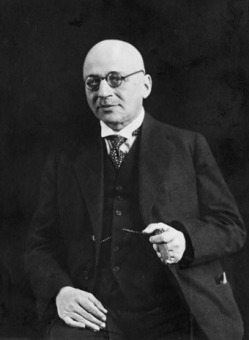Fritz Haber (1868–1934)

© Archive of the Max Planck Society, Berlin-Dahlem
“In peace for mankind, in war for my country.”[1]
Fritz Haber was born in Breslau on December 9, 1868, the son of the Jewish dye merchant Siegfried Haber and his wife, Paula (née Haber: a distant cousin). After finishing school, he studied physics and chemistry in Berlin and Heidelberg. He did his required military service in 1888, and in 1891 he received his Ph.D. in Berlin. After that, Fritz Haber received training in the chemical industry, learning about the business and about chemical technology. He converted to Protestantism in 1893. In 1898, just turned 30, he was named an assistant professor of physical chemistry at the Technical University of Karlsruhe. In 1901, Haber married the chemist Dr. Clara Immerwahr. He entered into a consulting contract with BASF in 1908, and in 1910, working together with Carl Bosch, he developed a process for synthesizing ammonia on an industrial scale. In 1912, he became one of the founders of the Kaiser Wilhelm Institute of Physical Chemistry and Electrochemistry, which he headed until 1933.
In World War I, Haber also was head of Chemical Department A 10 at the Prussian Ministry of War. The Kaiser Wilhelm Institute of Physical Chemistry and Electrochemistry expanded sharply, owing to the research work conducted there on gas warfare and gas protection methods. Under Haber’s guidance, poison gas was employed on the battlefield. A few days after the first release of chlorine gas at Ypres in 1915, his wife took her own life. In 1917, Haber married Charlotte Nathan. After the German defeat, the victorious powers demanded his extradition in 1918, to try him for violation of the Hague Convention Respecting the Laws and Customs of War on Land. He fled for a brief time to Switzerland, but shortly thereafter was able to return to Berlin. In the same year, 1918, he was awarded the Nobel Prize for Chemistry, “for the synthesis of ammonia from its elements.”[2] He played a part in the founding of the Deutsche Gesellschaft für Schädlingsbekämpfung (DEGESCH, German Corporation for Pest Control) and remained involved in research and development related to chemical weapons until 1933.
In 1926, Fritz Haber was invited to become a member of I.G. Farben’s supervisory board. After March 1933, he was supposed to dismiss Jewish employees in accordance with the will of the National Socialist government, but he chose to tender his resignation effective October 1, 1933, accepted an offer from Cambridge University, and emigrated to England. There he once again embraced the Jewish faith. Fritz Haber died on January 29, 1934, while traveling in Switzerland.
(SP; transl. KL)
















